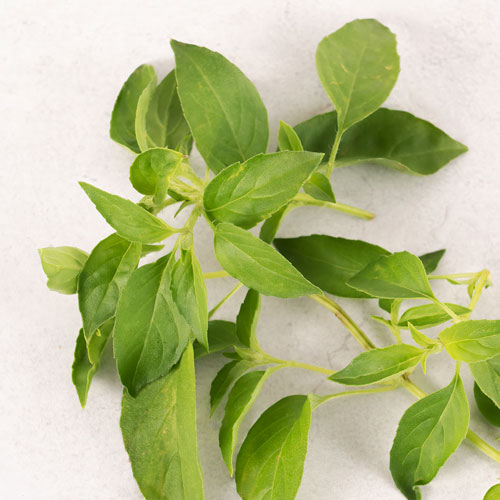Lime Basil
Latin name: Ocimum americanum ‘Lime’
🌱 Days to Sprout: 7-21
😋 Ready for Full Dose of plant food with true leaves or roots .5-inch long
✂️ Thin to: 3 plants per yCube
🍅 Days to Maturity: 55-65
💡 Light Zone: Medium
📏 Plant Size: <1 ft
💚 Care Level: Beginner
Origin
Lime Basil is an heirloom member of the mint family native to the tropical regions of Africa and Southeast Asia. Cultivated for hundreds of years, it came to the Americas in the 1700s yet has remained a rare variety in the US found only in specialty markets and some home gardens. Other common names, despite its origin, include American Basil, Hoary Basil, or Hairy Basil due to its fuzzy stems.
Qualities
Smooth green leaves offer a bright citrusy scent and peppery-lime flavor due to a volatile oil called citral. Some attest to the plant’s scent as a natural insect repellent for both people and plants when used in integrated pest management, along with its antibacterial and antioxidant properties. Lime Basil is high in vitamin K as well as calcium, iron, copper, magnesium, and folate. The small white flowers are also edible and make a delicate garnish.
Use
Best used fresh, try the leaves ripped, muddled, or whole in seafood, rice, or noodle dishes for an instant pop of zesty flavor. Fresh leaves also make tasty additions to fruit or vegetable salads, drinks, and even desserts - the options are endless!
Care & Harvest
✂️ Pruning: Remove leaves with brown spots if they appear. Check the roots monthly and trim any that are brown or extending past the yPod. For bushier growth, regularly harvest at the stem above the growth nodes (see Harvest below). To delay bolting, pinch off flower buds as they appear.
🔎 Plant Health: Aphids are a common pest, but you can use our prevention tricks to keep pests at bay!
🌿 Harvest: Harvesting frequently helps prolong the plant's life. Pinch off individual leaves, or use clean shears to cut stems above growth nodes. Find growth nodes just above the two largest leaves on a stem. You should see another, small set of leaves or knobs (nodes) growing between the stem and larger set of leaves. Cut the stem 1/4-1/2″ above the nodes and watch the small leaves grow large!
Our Plant Health & Nutrition Team thoroughly tests each variety we offer to bring you the most flavorful and high-quality plants. We regularly rotate our plant portfolio, so please note, availability varies.

